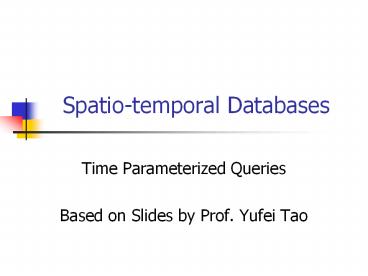Spatio-temporal Databases - PowerPoint PPT Presentation
1 / 22
Title:
Spatio-temporal Databases
Description:
Processing Complex Queries The proposed ... TP queries are preliminary components for Continuous queries Earliest event queries Conclusions The time ... – PowerPoint PPT presentation
Number of Views:69
Avg rating:3.0/5.0
Title: Spatio-temporal Databases
1
Spatio-temporal Databases
- Time Parameterized Queries
- Based on Slides by Prof. Yufei Tao
2
Intro
- The results of conventional spatial queries are
not very useful in dynamic environments because
they may be invalidated very soon due to the
movements of objects and queries.
3
The Time Parameterized (TP) Window Query
- Returns
- The current query result R
- The validity period T of R
- The change of result C at the end of T
Result
Rb
4
The TP Window Query
- Returns
- The current query result R
- The validity period T of R
- The change of result C at the end of T
Result
Rb, T1, C-b
5
The TP Nearest Neighbor Query
- Returns
- The current query result R
- The validity period T of R
- The change of result C at the end of T
Result
Rd
6
The TP Nearest Neighbor Query
- Returns
- The current query result R
- The validity period T of R
- The change of result C at the end of T
Result
Rd, T1.5, Cf
7
The TP Spatial Join Query
Result
R(A1, B1), (B3, A4)
8
The TP Spatial Join Query
Result
R(A1, B1), (B3, A4) T1 CA3, B2
9
Point Nearest Neighbor (NN) QueriesRoussopoulos
et al SIGMOD95, Hjaltason and Samet TODS 99
- Branch and bound algorithms use mindist between
the query point q and an R-tree entry E, to prune
the search space - mindist(E, q) The minimum distance between E
and q
10
Nearest Neighbor Search (NN) with R-Trees
- Depth-first (DF) and Best-first (BF) algorihms
11
Reducing TP Window Queries to NN Search
- Definition The influence time TINF(o, q) of a
data object o indicates the time when o will
change the current result of q.
- The object (C component) invalidating the current
query result is the one with the smallest
influence time (T component), i.e., a NN query
using TINF as the distance metric.
12
Reducing TP Window Queries to NN Search
- Definition The influence time TINF(o, q) of a
data object o indicates the time when o will
change the current result of q.
- The object (C component) invalidating the current
query result is the one with the smallest
influence time (T component), i.e., a NN query
using TINF as the distance metric.
13
Nearest Neighbor (NN) Search with R-trees
The algorithm is based on the Branched and Bound
framework.
We need 2 metrics (i) dist(o, q), and (ii)
mindist(E, q).
mindist(p1, q)
NN query
q
o1
2
o2
mindist(p3, q)
3
p1
2.5
3
mindist(p2, q)
o7
o6
o3
o5
p3
o4
p2
p1
p2
p3
o1
o2
o3
o4
o5
o6
o7
14
Processing TP Queries
- Treating TINF as the distance function, we may
apply the branch and bound paradigm to answer TP
queries. - Of course we must derive TINF for specific query
types. - Similar to mindist(E, q) for the NN search, we
also need TMININF(E, q), which is the minimum
influence time TINF(o, q) among all objects o
that can be in the subtree of E.
15
TINF for TP Window Query
- If an object intersects query q now, its TINF
equals the earliest time it stops intersecting q
in the future. - If an object does not intersect query q now, its
TINF equals the earliest time it starts
intersecting q in the future.
current time 0
TINF(u, q)2, TINF(v, q)1
16
TMININF for TP Window Query
- TMININF(E, q) equals the earliest future time E
starts to intersect q if, at the current time - E does not intersect query q, or
- E is contained query q
- TMININF(E, q)0 if E intersects (but is not
contained in) q
TMININF(E, q)0
TMININF(E, q)1
17
TINF for TP NN Query
- Assume PNN be the current nearest neighbor of
query q TINF of a data point o equals the time q
crosses the perpendicular bisector of line
segment PNNo
TINF(o, q)1.5
- Note that TINF for a TP NN query relies on the
current result (i.e., the current NN), while TINF
for a TP window query does not.
18
TMININF for TP NN Query
- TMININF(E, q) of a non-leaf entry E equals the
time mindist(E, q)dist(q, PNN). As with TINF, it
depends on the current query result.
19
BaB Algorithms for TP Queries
- For those queries (e.g., TP window) where TMIN
and TMININF do not depend on the current query
result, the T and C components can be retrieved
together with the R component in a single
traversal of the index structure. - For other queries (e.g., TP K-NN) where TMIN and
TMININF depend on the current query result, the T
and C components can be retrieved together with
the R component in separate traversals of the
index structure.
20
TP Spatial Join
- The TP spatial join is reduced to a closest pair
query following the similar idea.
A1 A2 A3 A4 A5
B1 2 ? ? ? ?
B2 ? ? 1 ? ?
B3 ? ? ? 4 2
21
Processing Complex Queries
- The proposed algorithms apply to other mobility
combination of objects and queries as well (i.e.,
mobile objects and static queries, mobile objects
and mobile queries). - TP queries are preliminary components for
- Continuous queries
- Earliest event queries
22
Conclusions
- The time-parameterized query can be integrated
with any spatial query type to retrieve
predictive information. - Processing of TP queries can be reduced to NN
search by defining appropriate distance
functions. - TP queries are preliminary building blocks for
more complex queries.































